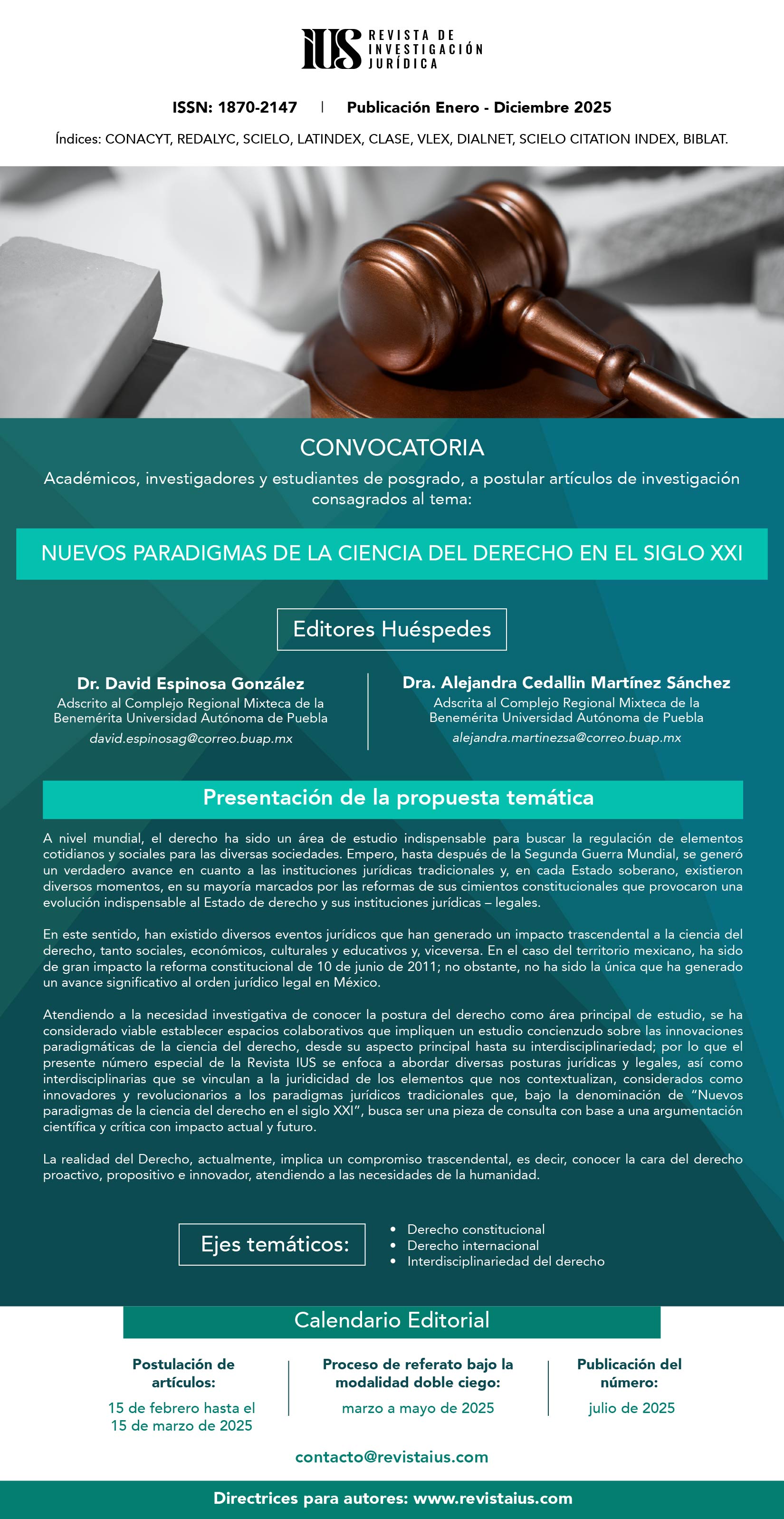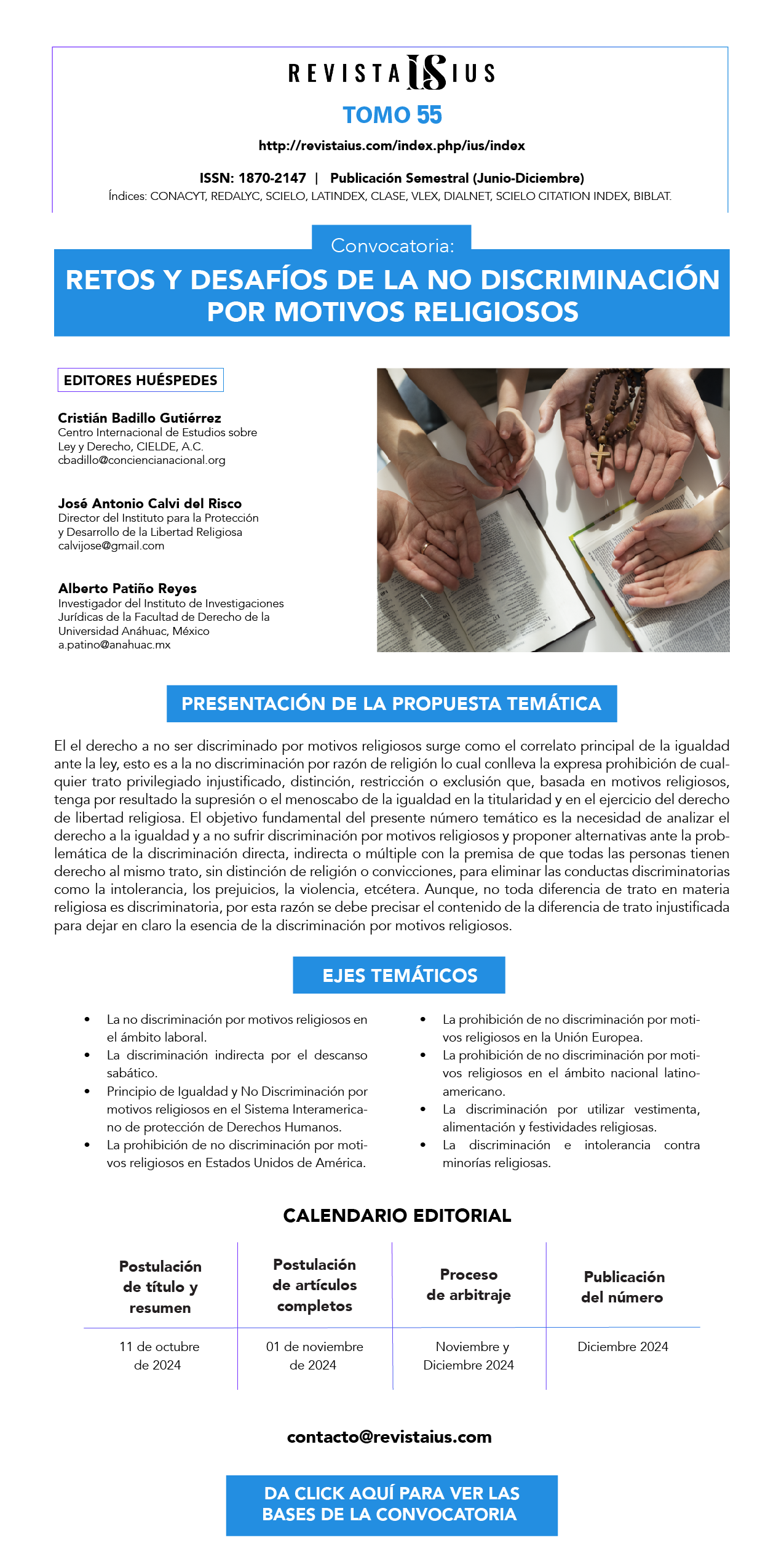Un debate complejo: la técnica de reproducción humana asistida post mortem desde la perspectiva comparada*
DOI:
https://doi.org/10.35487/rius.v11i39.2017.304Keywords:
Fertilización post mortem, Jurisprudencia, Derecho comparado, Derechos Humanos, Consentimiento informado.Abstract
El presente ensayo tiene por objeto problematizar y profundizar desde una perspectiva comparada la especial técnica de reproducción humana asistida como lo es la fertilización post mortem. Para este fin, se toman, a modo de disparador, recientes planteos judiciales esgrimidos en tres ordenamientos jurídicos con realidades y legislaciones bien diferentes como lo son Argentina, Francia y Gran
Bretaña, a los cuales también se debe sumar España siendo que uno de estos precedentes involucra a la regulación española.
Downloads
References
“Application for permission to appeal against an order dismissing the appellants’ claim for judicial review of a decision of the respondent, the Human Fertilisation and Embryology Authority, where the appellants had sought to have the gametes of their daughter exported to a treatment centre in New York”, Family Law Week. [Consulta: 2 de julio, 2016]. Disponible en: http://www. familylawweek.co.uk/site.aspx?i=ed159321
Gil Domínguez, Andrés, “El caso ‘Artavia Murillo II’: la Corte Interamericana de Derechos Humanos determina con precisión la fuerza normativa de la convencionalidad aplicada a un caso concreto”, Under Constitucional. [Consulta: 7 de septiembre, 2016]. Disponible en: http://underconstitucional.blogspot.com.ar/2016/04/el-caso-artavia-murillo-ii-la-corte.html
Herrera, Marisa, Reproducción artificial post mortem. Análisis del artículo 9 de la ley 14/2006 de 26 de mayo sobre Técnicas de Reproducción Humana Asistida, Valencia, Tirant lo Blanch, Valencia, 2013.
“Judgment in proceedings challenging the decision by the hfea to refuse permission to allow export and use of female gametes after death of the donor. Issues of consent, correct use of powers and engagement of Article 8”, Family Law Week. [Consulta: 2 de julio, 2016]. Disponible en: http://www.familylawweek.co.uk/site.aspx?i=ed145462
Juzgado Civil, Com., Lab. y de Minería núm. 4 de Santa Rosa, La Pampa, 30 de diciembre, 2015, “A., C. V. c/ Instituto de Seguridad Social-Sempre S/ Amparo”, Colectivo Derecho de Familia. Disponible en: http://www.colectivoderechofamilia.com/fa-pcial-juz-1ra-inst-civ-com-lab-y-mineria-no4-santa-rosala-pampa-fertilizacion-post-mortem/
Juzgado Nacional de 1a Instancia en lo Civil núm. 3, 3 de noviembre, 2014, “K. J. V. c. Instituto de Ginecología y Fertilidad y otros s/ amparo”, La Ley.
Kemelmajer de Carlucci, Aída, Herrera, Marisa y Lamm, Eleonora, “La Corte Interamericana de Derechos Humanos controla, sin concesión alguna, el cumplimiento de sus decisiones”, La Ley, 2016.
“‘N. O. C. P. s/Autorización’, Juzgado Nacional en lo Civil, No. 87, 05/05/2016”, El Dial. [Consulta: 10 de junio, 2016]. Disponible en: https://www.eldial.com/nuevo/lite-jurisprudencia-detalle.asp?id=39674&base=14&h=u
Rodriguez Guitian, Alma, “La reproducción artificial post mortem en España Estudio ante un nuevo dilema jurídico”, Revista Boliviana de derecho, No. 20, pp. 292-323. [Consulta: 12 de julio, 2016]. Disponible en: http://idibe.org/ wp-content/uploads/2013/09/121.pdf
Tercera Cámara de Apelaciones en lo Civil, Comercial, Minas, de Paz y Tributario-Mendoza, “S., M. C. s. Medida autosatisfactiva”, Rubinzal Culzoni. Disponible en: http://www.rubinzalonline.com.ar/fallo/9702/
The National Archives, “Use of sperm, or transfer of embryo, after death of men providing sperm”, Human Fertilization and Embryology Act 2008. Disponible en: http://www.legislation.gov.uk/ukpga/2008/22/section/39
“Tribunal Familiar núm. 3 Morón, 21 de noviembre de 2011, ‘G., A. P.’”, Revista de Derecho de Familia, No. 3, Buenos Aires, Abeledo Perrot, 2012.
Downloads
Issue
Section
License
Revista IUS, published by the Legal Sciences Institute of Puebla A.C., is distributed under the Creative Commons Attribution-NonCommercial 4.0 International (CC BY-NC 4.0) license.
We authorize collaborators to upload a copy of their published work on their personal websites or any Open Access repository, provided that Revista IUS is specifically cited as the original source, indicating the year and issue of the respective example and adding the link to the webpage on which this publication can be freely consulted in toto and without charge: http://www.revistaius.com
Readers are free to:
Share, copy and redistribute the material via any medium or format.
The licensor cannot revoke these freedoms as long as you follow the license terms.
Under the following terms:
Attribution: You must give appropriate credit, provide a link to the license, and indicate if changes were made.
You may do so in any reasonable manner, but not in any way that suggests the licensor endorses you or your use.
NonCommercial – You may not use the material for commercial purposes.
If you remix, transform or build upon the licensed material, its distribution is not permitted.
Charges for managing articles: Revista IUS will not charge for receiving, processing or publishing articles (Article Processing Charge, or APC) submitted by authors.





